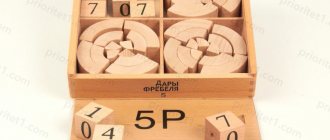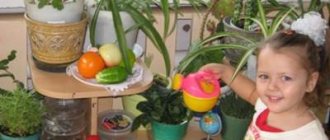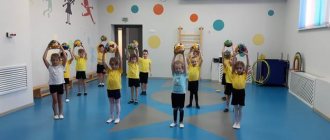Before starting to compile and write notes for an assignment in kindergarten, the teacher must:
- select the type of lesson;
- think over the structure;
- choose a rational form of training;
- think over the beginning of the lesson, its course and end;
- select the required number of games and activities;
- select didactic material;
- format the title page correctly.
Particular attention should be paid to the title page. Even if you looked at an example or sample, filling out the title page can still cause some difficulties.
If you also have questions about how to correctly format the title page of an assignment summary in kindergarten, then these recommendations will help you cope with this task 100%.
How to design a title page for an open lesson at a preschool educational institution
The title page of the summary of the assignment in kindergarten is drawn up in accordance with the requirements of the Federal State Educational Standard. It must reflect all input data:
- at the top of the title page the full name and name of the preschool institution is indicated;
- in the center of the sheet you must add the inscription: “Outline of continuous educational activities in ... (instead of an ellipsis, you must indicate a specific area);
- then indicate the name of the topic and age group;
- below you need to write the title of the abstract;
- in the lower right corner it is indicated who wrote the notes. The surname and initials of the author, his position, qualifications and category are indicated;
- The next item is the date of the lesson. It can be registered in two ways: November 16, 2021 or November 16, 2021;
- at the bottom of the title page, in the center, the city is indicated, and even lower, the year when the summary was written.
We will help with distance learning
Submit a request for a free cost estimate
MAGAZINE Preschooler.RF
Methodological recommendations for educators “How to correctly prepare a GCD outline in accordance with the Federal State Educational Standard for Educational Education”Some teachers have difficulty preparing GCD notes. Let's remember how this is done. Let's start with
title page.
The full name of the preschool institution is indicated at the top of the title page. Approximately in the middle of the sheet there is an inscription: Summary of direct educational activities in (Area) on the topic: “” for children of senior preschool age.
Below the title of the abstract, on the right, the surname, initials of the author and his position, group number are indicated.
At the bottom of the title page, in the middle, the city is written, and even lower, the year when the summary was written.
The next sheet begins with the gcd goal. What is a goal? The goal is the end result, what we strive for. It is recommended that the goal be determined by a noun from a verb: creating conditions, forming, educating, strengthening, etc. And tasks are formed by verbs in an indefinite form: create, strengthen, educate, implement, etc. The goals and objectives of the lesson replace the program content.
A task is something that requires execution or solution. Tasks in relation to the goal are and are:
- Educational tasks (write what we will teach children in this lesson). Do not write the verb “teach” ! It is more correct to write “to promote” , “to form skills” , “to create conditions” , “to develop”, etc.
- Developmental tasks (it is written that we will consolidate, clarify, not forgetting the development of mental functions and various properties).
- Educational tasks (what mental, aesthetic, moral and volitional qualities will be formed in this lesson).
It should be remembered that each new task is written on a new line.
When the tasks are formulated, it is necessary to indicate what preliminary work was carried out with children, the entire scope of frontal and individual work with children (Conversations with children, observation, reading fiction, where they went on an excursion, what they learned, etc.)
Methods and techniques: Playful, visual, practical activities for children, questions for children, verbal, didactic games, use of fiction, etc.
Materials and equipment: Lists what equipment will be used at this GCD (for example: tape recorder, flannelograph, easel, wall board, cubes, stands, etc.). Next, the demonstration material is indicated, which lists not only all the manuals and paintings, but also their authors, quantity, and sizes.
When describing handouts, it is necessary to list what material is taken, indicating the size and quantity.
The following describes the structure and methodological techniques used in the lesson. The parts of the lesson and specific methodological techniques are indicated.
For example:
Introductory part - 3 minutes,
a) reading the poem “Autumn” by A.S. Pushkin;
b) watching the autumn sky from the window;
c) verbal didactic game “Come up with a word” (selection of adjectives for the words sky, autumn, foliage),
II. The main part is 15 minutes. ^
a) conversation about weather phenomena in autumn;
b) looking at weather calendars; ^
c) physical minute; ugh
d) writing stories about autumn weather;
e) children naming autumn signs and sayings about autumn;
f) didactic game “Which tree is the leaf from” ... etc.
III. Final part - 2 minutes,
a) generalization by the teacher;
b) GCD analysis (about what knowledge the children showed).
And finally, a description of the progress of the GCD begins.
The GCD move is written in direct speech. Be sure to write down all the words that the teacher will say, the expected answers of the children, and the teacher’s generalizations. If during the lesson the teacher needs to perform some actions, this is indicated in the notes.
For example:
GCD move:
Poem "Autumn"
1. Reading the poem “Autumn” by A.S. Pushkin;
Educator: “Children, would you like me to read you a poem by A.S.
Pushkin's "Autumn" ?
Children: “Yes, we want!”
Educator: “October has already arrived - the grove is already shaking off the last leaves from its naked branches;
The autumn chill has blown in - the road is freezing..."
So, further on all points of the GCD structure.
So, if we briefly describe all of the above, the structure of the GCD summary is as follows:
If there is a title page, then the second page begins with the Objective, if without a title page, then it looks like this:
Topic: “Snowflakes Outside the Window” (Times New Roman 16)
(Secondary group No. 1, Ivanov I.I.) (Times New Roman 14) Educational field: Artistic and aesthetic development Goal:
Tasks:
- Educational:
- Educational:
- Educational:
- Preliminary work:
- Methods and techniques:
- Materials and equipment:
GCD structure:
I. Introductory part:
II. Main part:
III. Final part:
GCD move:
| Next > |
Sample title page for lesson notes in kindergarten
Abstract of the educational activity “I live in Togliatti” (in the preparatory group for school)
“I live in Tolyatti”
Target:
to form children’s ideas about their hometown of Tolyatti, knowledge about the cultural heritage of their small homeland. Build pride in your city.
Integration of educational areas:
O.O “Cognition”. To form children’s knowledge about their hometown, its attractions, and memorable places;
O.O. “Socialization”. Strengthen your behavior skills on the streets of your hometown; To foster pride and love for one’s hometown, to promote the moral education of children. Continue to cultivate friendly relations and a tolerant attitude towards people of other nationalities.
O.O “Reading fiction. Studying and reading poems and works about the city of Tolyatti.
O.O. “Communication”. Develop the ability to consistently express your thoughts, compiling a story from personal experience, and enrich your speech with definitions.
Vocabulary work
: friendly, beautiful, landmark, monument.
Preliminary work.
Readings of fiction about the hometown of Tolyatti,
memorizing poems, looking at photos about the city,
fixing the names of streets and attractions of the city of Tolyatti.
Material:
Drawings of the city, photographs of the city, city maps, tickets - flowers, microphone, emblems.
Progress of interaction
1.
Arrows appeared in front of the children - pointers.
Question:
Children, where are the arrows leading us?
Children:
Let's follow the arrows.
The teacher explains that the arrows led to the group plan, where the place where the children should go next is indicated.
Question:
Where in the group should we find the clue?
Children:
This is a corner of local history, where everything is told about our city of Tolyatti and the Samara region.
The teacher suggests going to this corner and finds a postcard with a picture of the city of Tolyatti and a printed poem on the back.
There is a young and early city on the Volga, the Automobile Plant is visible from everywhere, And boys live there, and girls live there, For whom the Volga circles and sings.
Question:
What city do you think we are talking about here? how did you guess?
— What is our city famous for? (There is VAZ, which produces Lada cars)
- We live in the city of Togliatti, and before it was ... (Stavropol - on - the Volga). You know that it was founded by... (Tatishchev Vasily Nikitich).
— If we live in the city of Tolyatti, what can we be called? (Tolyatti residents, townspeople, city residents).
— You and I talked about the city, read, drew pictures about the city. I think you know your hometown well. Do you want to prove it? Then I suggest, while remaining in the group, to go on a tour of your hometown. Anyone who really knows his city will be awarded the emblem of a true Tolyatti citizen. Do you agree? Then let's choose the type of transport we will use to travel.
The structure of writing a GCD summary in a preschool educational institution according to the Federal State Educational Standard
Municipal budgetary preschool educational institution
Kindergarten No. 12 “Bell”
Consultation for teachers
The structure of writing a GCD summary in a preschool educational institution according to the Federal State Educational Standard
The structure of writing a GCD summary in a preschool educational institution according to the Federal State Educational Standard
With the introduction of the Federal State Educational Standard, the approach to organizing and conducting direct educational activities with children is changing.
There is a rejection of traditional classes built in the logic of the educational model. The lesson is understood as an exciting activity with children, during which the teacher solves program problems. The role of the teacher is being rethought, becoming more of a “coordinator” or “mentor” than a direct source of information.
The position of a preschool teacher in relation to children changes and takes on the nature of cooperation when the child acts as an equal partner in a situation of joint activity and communication with the teacher.
Many teachers do not pay attention to the design of notes. The topic, purpose, and objectives are written in the notes. And often tasks pass through the goal.
Let's remember how this is done.
Let's start with the title page
The full name of the preschool institution is indicated at the top of the title page. Approximately in the middle of the sheet there is an inscription:
Abstract
Direct educational activities in (Region)
On the topic of: "……………"
for older children.
Below the title of the abstract, the author's surname and position are indicated on the right.
At the end of the title page, in the middle, your locality is written, and even lower, the year when the summary was written.
Next sheet
starts with program content.
This includes the purpose and objectives of the GCD.
What is a goal?
The goal is the end result, what we strive for. The goal is achieved through tasks, which in relation to the goal are means, i.e. how we will achieve this goal. It is recommended that the goal be determined by a noun from a verb: creating conditions, forming, educating, strengthening, etc.
Goal setting algorithm:
- Assess the existing problems and identify the main one, clearly formulate it.
- Determine the steps (actions) to solve it and their sequence.
- Formulate exactly the intermediate result (effect) from the execution of each step (action).
- Evaluate which (and how many) of these steps (actions) can be carried out within the framework of one GCD.
- Formulate the goal of the GCD, which contains a description of the effect of the actions that you plan to carry out within the framework of one GCD.
What an adult proposes to do must be necessary and interesting for the child, and the meaningfulness for the child of the activity proposed by the adult is the main guarantee of the developmental effect.
A task
is something that requires execution or solution.
Tasks in relation to the goal are and are:
Educational;
Developmental;
Educating.
It is recommended to formulate tasks with a verb in an indefinite form: consolidate, generalize, form, develop, educate, etc. Maintain clarity and specificity in the formulation of tasks (not just expand (consolidate) ideas about winter, but what exactly children learn (reinforce) about winter within the framework of this lesson). This also applies to the formulation of developmental tasks: not just the development of children’s mental abilities, but which ones specifically (list).
It should be remembered that each new task is written on a new line.
When the tasks are formulated, it is necessary to indicate what equipment
will be used on this GCD (for example: tape recorder, board, easel, wall board, cubes, stands, etc.).
The following is the demonstration material:
where not only all manuals and paintings are listed, but also their authors, quantity, and sizes are indicated.
Describing the handout material,
It is necessary to list what material is taken, indicating the size and quantity.
Next, it is necessary to describe the teacher’s previous work
in preparation for the lesson:
what was designed, what was produced, what was compiled, studied, written, etc. After this, preliminary work with children
, the entire scope of frontal and individual work with children (where they went on an excursion, what object they observed, what they read to the children, what they learned, etc.)
After this, it is written what individual work,
with whom (indicate the names and surnames of the children) in what part of the lesson it is planned to take place.
It is advisable not to forget to include this work in the part of the lesson in the notes in which you planned.
The following describes the structure
and
methodological techniques
used in the lesson.
The parts of the lesson and specific methodological techniques are indicated.
The summary also includes vocabulary work.
- these are new words, the meaning of which must be explained to children.
The parts of the lesson and specific teaching techniques are indicated.
.
The following describes the organization of children in direct educational activities.
The placement of tables, equipment, seating and placement of children is indicated - if necessary, a placement plan is included.
If the placement of children in different parts of the lesson changes, describe how the transition from one part of the lesson to another is carried out. And finally, a description of the course of the lesson
.
The course of the lesson is written in direct speech. Be sure to write down all the words that the teacher will say, the expected answers of the children, and the teacher’s generalizations.
If during the lesson the teacher needs to perform some actions, this is indicated in the notes. The lesson ends with words of analysis.
So, if we briefly describe all of the above,
the structure of the abstract is as follows:
- Type, type, topic of GCD indicating the age group of children
- Program content
(training, developing, educating tasks).
- Vocabulary work.
- Class equipment.
- Demonstration material.
- Handout.
- Previous work of the teacher in preparation for the lesson.
- Preliminary work with children
(with the whole group, with a subgroup, individually).
- Individual work with children on educational activities
(which one, with whom, in what part of the lesson).
- Lesson structure and methodological techniques.
- Organization of children in the classroom.
- Progress of the lesson (in direct speech).
At the end there are final phrases or analysis of the lesson.
We remind you about the types of classes:
1. Classes on communicating new knowledge. 2. Classes to consolidate knowledge, skills and abilities. 3. Lessons on generalization and systematization. 4. Final. 5.Accounting and verification. 6. Combined (mixed, combined). 7. Complex. 8. Integrated
(based on the principle of combining several types of children's activities and different means of speech development).
Integration can be on a thematic basis.
For example:
1) reading about birds; 2) collective drawing of birds; 3) storytelling based on pictures.
Additional Information
Do not forget about the methodological support of the pedagogical process. Any activity begins with a motive.
Motive
is a reason that motivates action. Previously, we called a motive a moment of interest before a lesson.
The following motives for activities for children are distinguished:
Gaming.
A child can realize his need for significance by “helping” various toys solve their practical and intellectual problems.
Motivation for communication.
Motivation is based on the child’s desire to feel necessary and important in helping an adult. An adult turns to a child with a request to help him, he says that there is no way to do without the child’s help. At the same time, he does not forget to thank the child.
Self-interest motivation.
This motivation encourages the child to create various objects for his own consumption.
After motivation comes the methodology for conducting the lesson. This section should highlight the parts of the lesson. Children's answers are not written in notes.



